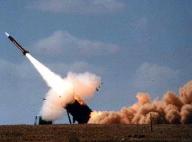India to test Anti-Missile Defence System today
 Orissa, Dec 6: India will conduct a second test of its Interceptor missile this afternoon as preparations for the trial of its Interceptor missile development programme, which has reached its final stage.
Orissa, Dec 6: India will conduct a second test of its Interceptor missile this afternoon as preparations for the trial of its Interceptor missile development programme, which has reached its final stage.
This interceptor missile will lift off on Thursday afternoon within seconds of an incoming missile, which will be launched from the Integrated Test Range (ITR) at Chandipur-on-sea, about 70 km across the sea from Wheeler Island.
Two missiles will be involved in the exercise. One will be used as the target, the other as an interceptor missile. The target missile is a modified version of India's Prithvi ballistic missile.
The 7.5- metre tall interceptor missile named Advanced Air Defence (AAD-02) has been placed on its mobile launcher on the beachfront.
The missile, painted in white, carried the emblem of the Defence Research and Development Organisation (DRDO) on top and the legends “Programme AD (Area Defence), AAD-02” below.
According to ITR sources, the Endo-atmospheric test will attempt to hit an incoming missile within the earth's atmosphere.
This test is aimed at establishing India’s capability for a two-layered Ballistic Missile Defence (BMD) shield for protecting vulnerable areas from an incoming enemy missile.
DRDO scientists were glued to their computer consoles at the Mission Control Centre (MCC) on Wheeler Island on Wednesday to complete the range integration checks.
The advanced anti-missile defence system will be slightly better than the American Patriot Advanced Capability - 3 (PAC-3) in terms of range and altitude of interception.
Missile scientist and Mission Director V.K. Saraswat was quoted by papers as saying that the target missile would be launched by the Army in an independent manner.
The Army is the custodian of the Prithvi because it had already been inducted into it. The vehicle director for the interceptor missile is D.S. Reddy.
“The interceptor is equipped with state-of-the-art inertial navigation system and electro-mechanical actuators to enable it perform critical manoeuvres required to engage the incoming missile during the latter’s terminal phase” added Saraswat.
The target missile would ‘mimic M-9 and M-11class of missiles in the world, which are with the adversaries.
The health of the interceptor missile and radar systems was checked as also the communication links between various elements of the weapon systems such as radars, MCC, Launch Control Centre.
The DRDO conducted a successful interception test of a missile at an altitude of 50 km in exo-atmosphere on November 27, 2006.
Meanwhile, the villagers living near Chandipur have been advised to shift to temporary shelters. (ANI)